Draft Energy Strategy and Just Transition Plan
We are consulting on this draft route map of actions we will take to deliver a flourishing net zero energy system that supplies affordable, resilient and clean energy to Scotland’s workers, households, communities and businesses.
Chapter 4: Energy demand
Our future energy use will be climate friendly
By 2030, Scotland's main energy using sectors - heat in buildings, transport, industry and agriculture - will be using energy more efficiently. The energy they do use will be largely decarbonised, helping to deliver against our economy-wide statutory climate change targets. We will see significantly reduced demand for energy overall and at least 1 million homes decarbonised. Car kilometres will have reduced by 20% and Carbon Capture Utilisation and Storage will be on its way to being an established technology in Scotland. At least the equivalent of 50% of our energy across heat, transport and electricity demand will come from renewable sources. By 2032, industrial emissions will have decreased 43% from 2018 levels, with industry remaining globally competitive.
This chapter sets out the transformation needed in how we use energy to deliver against our net zero, affordability and economic objectives, and details the actions we will take to change the way we use energy in our homes, in our transport systems, in industry and in agriculture. We will take action to reduce demand overall.
Meeting our targets will also depend on the reduction of fossil fuel energy use across industry, including the deployment of carbon capture, utilisation and storage (CCUS). To achieve this, we will continue to support the low carbon transition of industry in Scotland, call on the UK Government to accelerate the Scottish Cluster to full Track-1 status without delay and continue to implement the Emissions Trading Scheme.
Reducing demand and decarbonising our energy use across heat and transport sectors
Heating and cooling our buildings
We have set an ambition to decarbonise 1 million homes by 2030, and to reduce emissions from our non-domestic buildings.
We will consult during 2023 on a Heat in Buildings Bill and outline proposals for regulating energy efficiency and zero direct emission heat in Scotland's homes and buildings.
We will deliver support for the transformational change needed for heat in buildings through our National Energy Agency – Heat and Energy Efficiency Scotland.
We are investing over £1.8 billion in decarbonising homes and buildings, through Heat and Energy Efficiency Scotland, over the course of this parliament.
We have introduced a Home Energy Scotland Grant scheme in 2022/2023 including enhanced support for rural off gas households.
We will publish a Public Engagement Strategy for Heat in Buildings and the report from the Green Heat Finance Task Force in 2023.
We have set an ambition for 2.6 TWh of thermal energy to be supplied by heat networks by 2027 and 6 TWh by 2030, and will set a new target for 2035.
We will establish a new regulatory regime for heat networks in Scotland and appropriate financial mechanisms.
We will publish an updated target for renewable heat in 2023.
We will support local authorities to produce their Local Heat and Energy Efficiency Strategies (LHEES) and Delivery Plans by providing capacity support training in partnership with Zero Waste Scotland.
Energy for Transport
We have committed to reduce car kilometres by 20% by 2030, and are investing £500 million in active travel.
We are investing £500 million in bus priority measures and investing over £5 billion in maintaining, improving and decarbonising Scotland's rail network.
We are helping more people on lower incomes and remote/island communities to switch to zero emission vehicles with a further £30 million of loans and grants through our domestic and business EV funds.
We are developing a Just Transition Plan for Transport which will help create an energy system that delivers for people, places and communities in Scotland.
We are supporting innovation and attracting inward investment in zero emission mobility, including through the Michelin Scotland Innovation Park and the National Manufacturing Institute Scotland.
We will make up to £58 million available for zero emission buses and charging infrastructure.
We will accelerate the transition away from fossil fuels by supporting households and businesses to make the switch to low/zero emission vehicles, including:
- expanding electric vehicle infrastructure with £60 million of public and private investment.
- legislating to require new homes and non-residential buildings to include EV charging points.
- helping to facilitate the development and rollout of the infrastructure needed for hydrogen vehicles to operate in Scotland.
- delivering the rail decarbonisation plan.
- working towards decarbonisation of ferry services.
- working to decarbonise scheduled passenger flights within Scotland by 2040.
Supporting industry to reduce demand and decarbonise energy use
Energy for Industry
We will continue to offer match-funding support for industrial energy efficiency or decarbonisation via the Scottish Industrial Energy Transformation Fund (SIETF) with £34 million available to fund projects until 2026.
We call on the UK Government to work with us on getting consumers, or other buyers, to choose low carbon products
We will work with the UK Government to plan and secure the delivery of the substantial infrastructure, as well as new energy generation and conversion assets, that need to be developed before industrial fuel switching (to renewable or low – carbon hydrogen and/or to electrification) and CCUS can be deployed on a large scale.
We are supporting innovative proposals to reduce the carbon footprint of manufacturing through the Low Carbon Manufacturing Challenge Fund with £3 million in 2022 and a total of £26 million over 5 years.
Carbon Capture Usage and Storage
We will continue to work with the North East CCUS industry led alliance to support the delivery of the CCUS industry in Scotland
We will continue to engage with the Scottish Cluster and have offered £80 million from our Emerging Energy Technologies Fund until 2026 to support the deployment of the Scottish Cluster. Due to delays with the UK Government announcing the Scottish Cluster, we have re-profiled our offer of financial support into subsequent years.
We will support the development and demonstration of technologies that utilise carbon dioxide and create value in CO2 through our £5 million CO2 utilisation Challenge Fund
We will continue to provide funding and policy support to industry group NECCUS in financial year 2022/23, including on the development of Scottish Net Zero Road Map (SNZR)[77] which is scheduled to be completed in early 2023.
We will continue to build the evidence base for CCUS in Scotland, including exploration of non-pipeline transport solutions, such as CO2 shipping and the unique opportunities these provide to Scotland (initial outputs delivered in early 2023) and the CCUS regulatory landscape in Scotland.
We will work constructively with the UK Government on the development of CCUS in the UK and will continue to input into the Track-2 sequencing process to ensure it does not unfairly disadvantage Scotland.
We continue to call on the UK Government to reverse its CCUS cluster sequencing decision and to accelerate the Scottish Cluster to full Track-1 status without delay.
We also urge the UK Government to provide urgent clarity on the timelines and processes of the next stages (Track-2) of the cluster sequencing process.
Energy in Agriculture
We are providing advice and support to help farmers and crofters reduce energy demand and decarbonise energy use though a suite of advice programmes.
We are building our evidence base through research on opportunities to reduce demand and decarbonise energy usage across the agricultural sector.
Emissions Trading
We are currently developing the UK ETS to align it with our net zero targets. We consulted on proposals with the UK Government, Welsh Government and Northern Ireland Executive in March-June 2022 and will bring forward legislation in response to these proposals in 2023.
We will continue to work with industry to support them to make the decarbonisation investments needed in the context of the price signal from the ETS.
Reducing demand and decarbonising our energy use
As the energy transition progresses, we will all see changes in our day-to-day consumption habits. This will include increased use of public transport or active travel, and reduced heat demand by improving the energy efficiency of our homes and non-domestic buildings.
Changes to the way we use energy (or 'demand-side measures') can deliver significant co-benefits for people and society, including improvements in health and wellbeing, contributing positively to a just transition. Reducing energy demand has the double benefit of saving emissions and lowering energy and infrastructure costs. By using less energy overall through energy efficiency, we can reduce the negative impact of fluctuating energy prices.
Feedback from engagement
Stakeholders called for improved incentives to encourage the switch to cleaner energy and reduction of energy use for consumers and businesses alike. This includes investment in public transport, supporting costs of energy efficiency measures and enhancing the coordination of retrofit schemes.
4.1 - Energy for heat in buildings
Heating Scotland's building stock accounted for 51% of our energy consumption and is a significant source of emissions[78]. As set out in our Heat in Buildings Strategy[79] (HiBS) we need to transform the way we heat our homes, workplaces, communities and other public buildings. This will involve using less energy by improving energy efficiency, and moving to zero emissions heating systems.
Use of hydrogen for heating
We do not consider that hydrogen will play a central role in the overall decarbonisation of domestic heat and therefore we cannot afford to delay action to decarbonise homes this decade through other available technologies.
The potential for hydrogen to play a role in heating buildings depends upon strategic decisions by the UK Government that will be made over the coming years. The Scottish Government will continue to urge the UK Government to accelerate decision-making on the role of hydrogen in the gas grid.
The gas industry is testing options for blending hydrogen into the gas network up to the limit that can be safely used in existing appliances. Using a blend of hydrogen up to 20% by volume has the potential to reduce carbon emissions from gas use by up to only 6-7% on current GB grid gas consumption. There is also potential for some parts of the gas grid in Scotland to be converted to 100% hydrogen in the 2030s and beyond, in specific circumstances such as rural island areas, Statutory Independent Undertakings (SIUs)[80] or areas of potentially high levels of hydrogen use.
The Scottish Government is seeking to commission independent laboratory testing of hydrogen boilers to determine what – if any – greenhouse gas emissions are produced from the combustion of 100% pure hydrogen (under normal operating conditions). Once the testing has concluded, in early 2023, we will set out our position on the use of 100% hydrogen for space and hot water heating in new buildings.
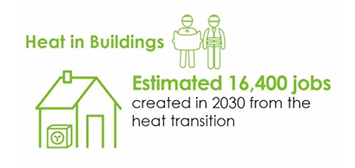
It will take an unprecedented level of leadership and co-ordination to ensure everyone, from industry to individual households, is aware of, and understands, the changes required to deliver this green heat transformation. A key factor will be to ensure everyone can access the right support, at the right time, to meet their needs as they move through this transition. That is why we made a commitment to establish a dedicated National Public Energy Agency by 2025.
However, in recognition of the urgency to act now, we launched a virtual Agency in October 2022 – Heat and Energy Efficiency Scotland. The agency's initial focus will be to build public understanding of the changes needed in how people heat and use energy in their properties, act as a centre of expertise for green heat projects and co-ordinate investment. We have committed £1.8bn over the course of this parliament, to support the work of Heat and Energy Efficiency Scotland.
We have already expanded the capacity of our Home Energy Scotland (HES) advice service and have introduced a new HES grant scheme for households during 2022/23, including enhanced support for rural off-gas households. Businesses can access free energy advice via Business Energy Scotland, and drive change within the SME sector through financial support via the SME Loan and Cashback scheme.
We will consult during 2023 on a Heat in Buildings Bill and outline proposals for regulating energy efficiency and zero direct emission heat in Scotland's homes and buildings. We will also publish a Public Engagement Strategy and the report from the Green Heat Finance Taskforce in 2023. This will focus on raising awareness and understanding about why we need to change the way we heat our homes and buildings, the benefits this can deliver, the changes people will need to make and the support and advice that will be available to help achieve this.

Heat networks will also have a big part to play in providing clean heat across Scotland. We are supporting these through our £300 million Heat Network Fund, available over the next parliamentary session. We have set an ambition for 2.6 TWh of thermal energy to be supplied by heat networks by 2027 and 6 TWh by 2030, and will set a new target for 2035. We continue to support the deployment of heat networks in Scotland through the Heat Networks (Scotland) Act[81], which will be implemented by 2024 to establish a new regulatory regime for heat networks in Scotland.
In order to comply with existing statutory requirements, our Heat in Buildings Strategy set out a new provisional target (22%) for the proportion of non-electrical heat demand in buildings supplied by renewable sources (either directly, or via a heat network). The Renewable Heat Target (RHT), as currently defined, is an important factor in monitoring Scotland's wider 2030 renewable ambitions. However, we believe that the current RHT alone is insufficient to measure progress towards our Heat in Buildings ambitions. These are to displace Direct Emissions Heating with Zero Direct Emissions Heating, which could include, but not be restricted to, non-renewable sources. We will be considering alternative approaches and metrics against which to measure our progress over the coming year, and will engage with stakeholders as part of this process.
Climate resilience
Some buildings also require energy for cooling. At present, this is more relevant for non-domestic properties, such as hospitals, larger open plan offices, hotels and retail units. As our climate changes, we are likely to experience increased temperatures, with warmer winters and hotter summers becoming more common. As a result, we are likely to see an increased demand for cooling in the future. Some of this will be met through changes to building design and the deployment of natural solutions. However, we recognise that it will be important to understand the need for, and role of, zero emission technologies that can also provide cooling, such as reversible heat pumps.
Benefits to climate and the environment
The Heat in Buildings Strategy sets out a pathway for the way in which zero emissions heating systems, accompanied by measures to reduce the amount of energy that we use, will keep us on course to achieve our binding emission reduction targets. It includes a series of actions for the near term and beyond, including the principles we will apply to ensure that those actions, and our accompanying programmes of support, are consistent with our fuel poverty objectives and commitments, and with a just transition.
Maximising benefits to our economy, businesses and workers
The recent 'Decarbonising Heating – Economic Impact'[82] report estimated almost 16,400 additional jobs could be created in 2030 across the Scottish economy from the heat transition, with further jobs supported through the roll out of energy efficiency. We are focused on the opportunities to develop new supply chains and jobs that the heat in buildings transformation can provide, including through our work on a Supply Chain Development Programme for Heat Pumps, and our Heat in Buildings Supply Chain Delivery Plan, which was published in November 2022. This has been developed with input from across the Scottish public sector and is designed to strengthen the supply chains that will manufacture and install the new heating systems and energy efficiency measures we need.
Benefits to our communities and regions
There is strong evidence that home energy efficiency improvements can have positive impacts on health and well-being, particularly when targeted at vulnerable groups[83]. These include reduced symptoms of respiratory problems, cardiovascular conditions, arthritis and allergies, as well as improved mental health outcomes.
Our Community and Renewable Energy Scheme, CARES, has an enhanced focus on heat decarbonisation of community buildings, reaching urban and rural communities across Scotland to make buildings warmer, greener and cheaper to run. It also enables them to continue delivering essential local services and acting as exemplars so people can experience low carbon technologies in their community.
Local Heat and Energy Efficiency Strategies (LHEES) are the principal mechanism for locally-led heat planning in Scotland. LHEES will support local planning, coordination and delivery of the heat transition and provide an area-based 'blueprint' for decarbonising buildings. All local authorities must produce LHEES Strategies and Delivery Plans by the end of 2023 and update them every five years. A multi-year funding package is now in place to ensure that local authorities are properly resourced to develop their LHEES, and many are well on their way to publishing strategies. We will support local authorities to produce their LHEES Strategies and Delivery Plans by providing capacity support training in partnership with Zero Waste Scotland.
We are also collaborating with international governments, for example through our Memorandum of Understanding with Denmark, and examining international delivery mechanisms that could be applied to the Scottish energy sector – where competent to do so – such as municipally owned energy service companies.
4.2 - Energy for transport
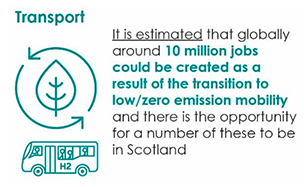
Our ambition for Scotland, as set out in the National Transport Strategy[84], is to have a sustainable, inclusive, safe and accessible transport system helping deliver a healthier, fairer and more prosperous Scotland for communities, businesses and visitors.
Transport is currently a significant user of fossil fuels, accounting for 25% of Scotland's energy consumption in 2019[85]. Decarbonising the sector creates multiple opportunities for transport to play a different role in the energy system. Renewable electricity and hydrogen will meet the vast majority of future transport energy needs, and the transport sector will also play a greater role in providing energy storage and flexibility through vehicle to grid and reuse of batteries. See more details in Chapter 5. Greater integration of the transport and energy systems can help us create a fairer, wealthier and greener Scotland: a Scotland where low and zero emission transport is affordable and reliable.
Our national demand forecasts[86] indicate that meeting our emission reduction targets through reducing car use and switching to electricity and hydrogen will result in a gradual increase in demand for renewables through the 2020s. A significant acceleration in demand would follow by 2030, implying that we need to start rolling out the supply and infrastructure for transport decarbonisation during this decade.
Hydrogen use in the transport system
Hydrogen and hydrogen-based fuels could decarbonise parts of the transport sector where full electrification is challenging, such as the aviation and maritime sectors.
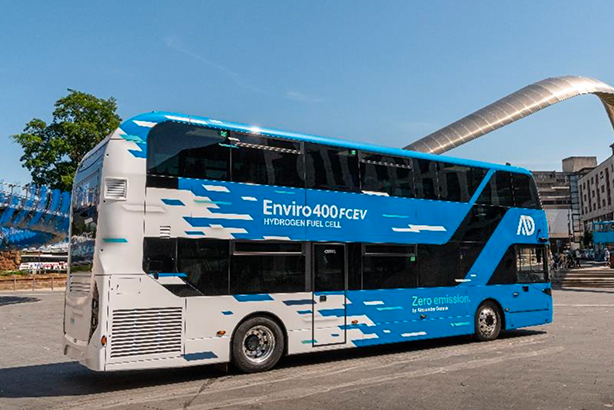
Photo credit: Alexander Dennis.
Our forecasts indicate that demand for hydrogen in the transport sector has the potential to increase to around 6 TWh a year by 2035.[87] This is equivalent to around 80% of the diesel used by Heavy Goods Vehicles (HGVs) on Scotland's roads in 2019. By 2045, this could be as high as 14.9 TWh.
We have supported hydrogen demonstration projects in the transport sector, including the development of Scotland's first hydrogen powered train and LOCATE, a drivetrain testing facility supporting the development of hydrogen niche and heavy-duty vehicles.
The Hydrogen Action Plan sets out how we will facilitate the use of hydrogen vehicles.
We aim to reduce the need to travel by car and increase the proportion of journeys by active travel or public transport. We do not expect car use to reduce equally for all – for example rural communities will continue to have a higher reliance on private vehicles – but we want to encourage and support those who are able to change their travel behaviour to do so.
We want to transition all vehicles to run on zero emission energy, including cars, buses, HGVs, ferries, and planes, wherever possible. Our aim is for most modes of transport to transition directly to zero-emission fuels and to avoid low-emission fuels as an interim stage wherever technically possible. Any support for low-emission fuels would be dependent on evidence that use of low-emission technology would not lead to a delay in achieving fully zero-emission transport. Overall, we want transport to use less energy in the future, and for the energy used to be affordable and reliable as shown in the transport hierarchy below.
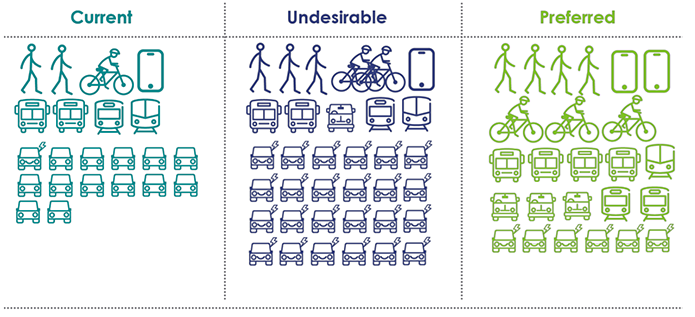
Source: NTS 2 – National Transport Strategy
Benefits to communities and regions
The importance of affordable energy has been shown by the impact that increased fuel prices have had on people who cannot easily switch to other modes of transport. For example, people living in rural areas, or blue badge holders, who are reliant on their car.
The current approach to motoring taxation is a significant barrier to the decarbonisation of the transport sector, particularly here in Scotland. We will continue to press the UK Government to implement reforms. Longer term, we want those least able to pay to benefit most from the switch to cleaner vehicles, reducing their cost of travelling as well as being more environmentally friendly.
In addition to our targeted support for rural and island areas (See Annex I), to support the people of Scotland through this period, we have put in place measures to help make public transport more affordable. This includes freezing all ScotRail fares until March 2023 and the Network Support Grant to support bus services in keeping fares more affordable and networks more extensive. Additionally, we are undertaking the Fair Fares Review to consider the range of discounts and concessionary schemes available on all modes of transport to ensure a sustainable and integrated approach to public transport fares. This includes a review of ferry fares policy for the Clyde and Hebrides Ferry Services (CHFS) and Northern Isles Ferry Services (NIFS) networks.
Benefits to climate and the environment
Low Emission Zones have been introduced in Aberdeen, Dundee, Edinburgh and Glasgow to help to improve air quality. Poor air quality has a negative impact on everyone's health, especially the very young, the elderly and those with pre-existing health conditions. The Low Emission Zone Support Fund aims to help those who would have the most difficulty adapting to the introduction of Low Emission Zones. This includes support to convert vehicles to LPG and we have been working with local councils and the private sector to help improve the availability of LPG.
Maximising benefits to our economy, businesses and workers
The transition from a fossil fuel-powered transport system to a low/zero emission system presents economic opportunities for Scotland. It is estimated that globally around 10 million jobs[88] could be created as a result of the transition to low/zero emission mobility. With Scotland's strengths in big data, sensors and digital technologies – all of which are important for efficient route planning, smart charging[89] and vehicle to grid technology – there is the opportunity for a number of these jobs to be in Scotland.
Scotland also has expertise in power system and grid integration for electrification, advanced manufacturing and integration of renewables. This expertise can help Scotland gain a share of the expanding market for refuelling and recharging infrastructure, as well as energy storage. See Chapter 5 for more details on flexibility.
By population, Scotland has the most public electric vehicle charging points outside of London, and the most rapid charge points anywhere in the UK. Through the PACE project[90] we supported new approaches to planning and installation of public charging points, demonstrating that making effective use of the existing electricity network can potentially achieve average cost savings of between £30,000 and £60,000 on average per location.
Scotland has the UK's first fleet of double deck hydrogen buses, and three of Scotland's seven cities are already connected by a modern electrified rail network. Glasgow's Smart Street[91] shows what is possible if all parts of the energy system work together. For example, the street will have street lighting which integrates the electric vehicle-charging point into the lighting column. The lighting column transmits and receives data so that vehicles are charged at the best times and the street lights are only on when needed.
4.3 - Energy for agriculture
We have an ambition to reduce energy use in agriculture and to maximise opportunities for land managers for generating zero carbon energy. Agricultural energy use accounts for 0.8 MtCO2e, 2 % of Scotland's total emissions and includes energy used for agricultural vehicles and processes. Approximately 300 million litres of (red) diesel (equivalent to 3 TWh) is consumed each year by the agriculture sector in Scotland. This is over 10% of Scotland's total estimated diesel consumption[92].
Energy demand on farms and crofts can be high for numerous reasons, including heating animal sheds, drying grain and powering heavy machinery. These processes currently tend to rely on fossil fuels. Through Farming for a Better Climate, Scotland's Farm Advisory Service, the Knowledge Transfer and Innovation Fund and Business Energy Scotland, we provide advice and support to help farmers and crofters cut energy use and carbon emissions, thereby reducing costs and supporting our vision for agriculture. We also provide advice and support on the opportunities available to produce renewable energy, offering a diversified income stream.
To inform how we decarbonise tractors and machinery, we are undertaking analysis on the 'Decarbonisation of mobile agricultural machinery in Scotland'. This will shape the policies we develop as part of the upcoming Climate Change Plan.
We will take forward an Agricultural Bill to deliver the powers that will enable the realisation of our Vision for Agriculture. This Vision aims to ensure Scotland will be recognised as a leader in regenerative and sustainable farming.
We will build our evidence base through a range of research including:
1. The opportunities and risks of developing a Scottish anaerobic digestion market from agricultural wastes to produce biomethane, CO2 and digestate.
2. Private sector drivers for climate change action in Scottish agriculture.
3. Increasing low-carbon energy production and use in Scottish agriculture through a whole systems approach.
4. Decarbonisation of mobile agricultural machinery in Scotland.
Case Study: Woodend Farming Partnership, Scottish Borders
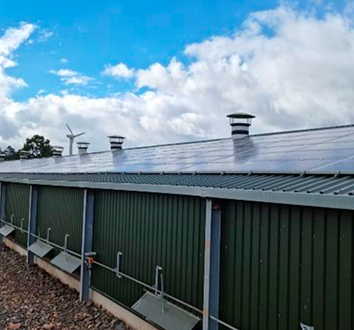
Photo Credit: John Seed
The Woodend Farming Partnership focuses on free range egg production and arable cropping. To make the business more resilient, a 950kW biomass boiler was installed in 2013 to dry grain and provide heat to the egg pack house and properties on the farm via a district heating system.
The farm has 125kW of solar panels and a 75kW wind turbine to provide nearly all the power needed to run the grain dryer and farm.
There are plans to install electric vehicle chargers and battery storage at every house on the farm as Woodend moves towards having 100% electric vehicles. Through investing in energy production and adopting low-carbon, energy-efficient production systems, the farm will maintain and even improve its resilience and profitability. To read the full case study visit: www.farmingforabetterclimate.org
4.4 - Energy for industry
The energy intensive sectors of oil and gas refining, cement, pulp and paper, food and drink, iron and steel, chemicals, glass and ceramics, together account for around 15% of Scotland's greenhouse gas emissions[93]. We have an ambition to achieve a 43% reduction in industrial emissions by 2032, but we recognise that industry is likely to be a source of residual emissions in 2045. This emphasises the need for technologies that can remove and lock away carbon i.e. negative emissions technologies (NETs) and carbon capture, utilisation and storage (CCUS). Industrial decarbonisation will require systemic change involving energy efficiency, electrification, CCUS and fuel-switching, in particular to hydrogen.
As we work to support the efficient decarbonisation of industry, incentives must focus on increasing energy efficiency. This will not only reduce emissions, but will protect industry from future energy price volatility. During the current energy crisis, we must also ensure that policy is responding to commercial cases of energy intensive industries.
We will continue to offer match-funding support for industrial energy-efficiency or decarbonisation via the Scottish Industrial Energy Transformation Fund (SIETF). £34 million is available to fund projects until 2026. To date, over £12 million has been offered in grants to around 20 industrial sites with more to follow.
We call on the UK Government to work with us on getting consumers, or other buyers, to choose low carbon products; and ensure these choices influence the long-term investment decisions on energy consumed during production by manufacturing industries. We also want to work with the UK Government to plan and secure the delivery of the substantial infrastructure, as well as new energy generation and conversion assets, that need to be developed before industrial fuel switching (to renewable hydrogen and/or to electrification) and CCUS can be deployed on a large scale.
Low carbon manufacturing
We recognise the need to support manufacturers to reduce their carbon emissions. The Low Carbon Manufacturing Challenge Fund (LCMCF) was announced by the First Minister in early 2022 as part of a wider £60 million investment in industrial decarbonisation. Innovative proposals to reduce the carbon footprint of manufacturing will be supported with £3 million funding in 2022 and a total of £26 million over five years. It is designed to build on Scotland's existing expertise, encouraging partnerships to come forward with bids that will support the adoption or development of low carbon technologies or processes.
Maximising benefits to our economy, businesses and workers
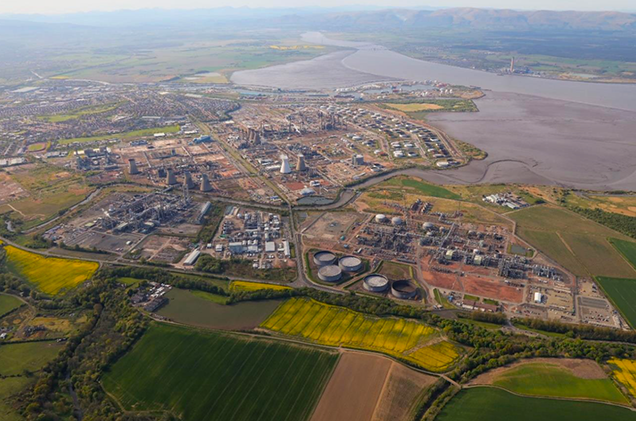
Photo credit: INEOS
We want to encourage innovation in reducing emissions. The National Manufacturing Institute Scotland (NMIS) is a cutting-edge facility which represents a £75 million investment in the future of the sector. Through helping manufacturers to be more efficient, productive and cost-effective, many aspects of its mission overlap with our desire to promote the reduction of carbon emissions in the manufacturing process. We have learnt that many businesses struggle to understand the carbon impact of their operations. For this reason, we launched a CivTech Challenge in 2021 to explore how technology can help manufacturing businesses decarbonise while building resilience and strengthening competitive advantage. We are now working with a Scottish start-up – iSumio – who plan to be in a position to launch a beta product by the end of 2022. To date, this work represents the largest value of any CivTech pre-commercialisation contract.
Grangemouth is home to the largest base of industrial manufacturing in Scotland. This industrial cluster plays an important part in Scotland's current energy system. However, the area is also responsible for 8% of Scotland's carbon emissions. Given the critical role of Grangemouth, both for our economy and our climate change targets, it is our ambition to see the site remain not only a key manufacturing base for the future, but also one that is significantly decarbonised, supporting further carbon reduction across Scotland. Grangemouth already presents a clear opportunity to achieve this through an extensive range of knowledge, skills and experience. For example, the production and handling of hydrogen requires a depth of chemicals expertise that is highly compatible with bio-based manufacturing. This existing knowledge base has the potential to attract new and innovative industries via co-location to become an anchor point for low-carbon supply chains. This is an opportunity that could further Grangemouth's status as an exemplar low-carbon cluster, whilst maintaining, re-purposing and growing skills and training for jobs that will be necessary in a net zero economy. Grangemouth is ideally placed to produce future products in a net zero economy, and the region can also enable decarbonisation across other regions and sectors within Scotland. There is significant potential for carbon intensive industrial clusters, such as Grangemouth and Mossmorran, to unlock deeper decarbonisation across Scotland. In particular, Grangemouth's wealth of investment, infrastructure, skills, knowledge and productivity has strong potential for supporting a net zero economy.
Benefits to our communities and regions
The transition for Grangemouth must be a just one that shares the costs and benefits fairly across the broader region. In support of this, the Scottish Government, with partners across the Grangemouth Future Industry Board, is working to deliver a Just Transition Plan for the Grangemouth Industrial Cluster. The plan will outline a shared vision for future operations in a net zero world, identifying actions to help achieve this.
Case study: National Manufacturing Institute Scotland
Automotive manufacturers are looking to find more efficient manufacturing process routes to reduce emissions and input material weight. Alloy wheels, traditionally manufactured through casting or multi-stage forging and flow forming, can be energy intensive and time-consuming to produce, with significant heat and machining required. The Advanced Forming Research Centre (AFRC), a part of the NMIS Group, demonstrated the potential of hybrid split forming and flow forming to produce a lower carbon footprint alloy wheel for the automotive industry. The alloy wheel component was formed in a cycle time of three minutes, compared to 10-30 minutes for the conventional process. No heating was required, which could yield significant energy savings, whilst eliminating joining methods substantially reduces machining requirements. The AFRC is now engaging in dialogue with leading automotive manufacturers interested in embracing split and flow forming within their operations. Source: www.nmis.scot
4.5 - Carbon Capture, Utilisation and Storage (CCUS)
Carbon capture, utilisation and storage will be essential for capturing residual emissions in our energy system[94]. CCUS will play a role in reducing emissions in hard to decarbonise industrial sectors that cannot electrify their industrial processes[95]. It is also a key enabler for negative emissions technologies (NETs), which are critical for reaching net zero.
Scotland has vast potential for CO2 storage in the North Sea, estimated to be up to 46 Gt of CO2 storage in Scottish waters.[96] This is estimated to be over half of the UK's total CO2 storage capacity, providing a route for much of the UK's emissions to be safely stored.
The Scottish Government remains supportive of these technologies as part of the energy transition and in particular it remains committed to supporting the delivery of the Scottish Cluster (known as the Acorn project). However, we agree that any strategy for deployment of these technologies must enable decarbonisation at pace and cannot be used to justify unsustainable levels of fossil fuel extraction or impede Scotland's just transition to net zero.
While the probability of CO2 leaks from a regional CCS industry has been shown to be low and if leaks do occur the spatial scale of impact is likely to be small and the potential environmental impacts minimal[97], robust monitoring is important. Also important is the setting of high performance standards for CCUS facilities. The UK Government has set minimum CO2 capture rates as part of a number of performance conditions in its cluster sequencing process[98] and in the business models that are currently being developed e.g. for industrial carbon capture[99] and power CCUS[100].
Case study: The Scottish Cluster (Acorn)
The Scottish Cluster, led by the Acorn Project at St Fergus, is critical to delivering on Scotland's potential to develop a viable CCUS industry[101]. The Acorn Project has potential to store up to 5 million tonnes of CO2 per annum by 2030. Its access to Peterhead Port gives the project potential to become a European hub for a whole new CO2 shipping economy and attract significant inward investment.
CCUS has now been deployed worldwide, but it does not have an established market in the UK and requires revenue and capital support. The UK Government's decision to not award the Scottish Cluster Track-1 status in their CCUS cluster sequencing process has generated significant uncertainty on the timely deployment of CCUS in Scotland and, therefore, our ability to achieve our emissions reduction targets and economic ambitions as part of a just transition.
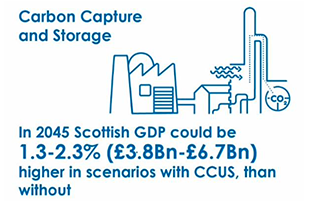
Although the Cluster has been granted "reserve status", this does not provide any guarantee of support and no projects linked to the Scottish Cluster have been progressed in Phase-2 of Track-1. Delays in the deployment of CCS infrastructure in Scotland will require contingency planning to identify the additional emissions reduction effort that may be needed from other sectors to meet Scotland's 2030 target. This will be explored in the 2023 Climate Change Plan.
We therefore continue to call on the UK Government to reverse its CCUS cluster sequencing decision and to accelerate the Scottish Cluster to full Track-1 status without delay. We also urge the UK Government to provide urgent clarity on the timelines and processes of the next stages (Track-2) of the cluster sequencing process. We are also working constructively with the UK Government on the development of CCUS in the UK and will continue to input into the Track-2 sequencing process to ensure it does not unfairly disadvantage Scotland.
Maximising benefits to our economy, businesses and workers
Scotland's industrial clusters in the North East and in Grangemouth are linked by a network of pipelines to oil and gas fields in the North Sea. This offers rare access to existing legacy infrastructure for carbon storage and provides Scotland with a competitive advantage in CCUS. Peterhead Port provides opportunities to commence CO2 shipping, unlocking potential for Scotland to be the centre of a European hub for the importation and storage of CO2 from Europe. Our experience in oil and gas also means we have much of the expertise and transferable skills to kick-start what could become a whole new on and offshore industry for Scotland.
By deploying CCUS, low-carbon hydrogen and direct air capture technologies in Scotland, the Scottish Cluster (led by the Acorn CCUS Project at St Fergus) could support an average of 15,100 jobs between 2022-2050, with a peak of 20,600 jobs in 2031[102].
Scottish Government economic scenario analysis shows CCUS would have a positive impact on the Scottish economy. In 2045 Scottish GDP could be 1.3-2.3% (£3.8 bn-£6.7 bn) higher in scenarios with CCUS, than without.[103]
We are continuing to engage with the Scottish Cluster and have offered £80 million from our Emerging Energy Technologies Fund until 2026 to support the deployment of the Scottish Cluster. Due to delays with the UK Government announcing the Scottish Cluster, we have re-profiled our offer of financial support into subsequent years. We will continue to explore how this funding can best be utilised to operationalise CCUS in Scotland. We also continue to build the evidence base for CCUS in Scotland, including exploration of non-pipeline transport solutions such as CO2 shipping and the CCUS regulatory landscape in Scotland.
In addition to the Scottish Cluster, we benefit from the presence of significant industry and academic expertise that is committed to operationalising CCUS in Scotland. Launched in November 2019, North East CCUS (NECCUS) is an industry-led alliance drawn from industry, academia, membership organisations and private sector bodies to promote CCUS in Scotland. It currently has over 50 members comprising the majority of Scottish industrial emissions, and is leading on critical projects such as the development of the Scottish Net Zero Route map (SNZR). We will continue to work with these experts in delivering a viable CCUS industry in Scotland.
At present, there are no plans by industry to develop Bioenergy Carbon Capture and Storage (BECCS) technology at scale in Scotland. In order to enable the delivery of BECCS for power generation and biomass gasification at scale, a sustainable biomass supply chain, CCUS technology and infrastructure, and a route to market will be required. The scenarios we commissioned to inform this draft Strategy suggest the main role of BECCS in the long term would be to support hydrogen production and industrial processes. See Chapter 3 for more details on the Bioenergy Action Plan.
4.6 - Emissions trading
While we must decarbonise our industrial and power sectors at an ambitious pace, we must also work with Scottish industry to manage the transition to net zero and ensure it can continue to compete in global markets. The UK Emissions Trading Scheme (UK ETS) establishes a market price for carbon and incentivises business investment in least cost decarbonisation. The UK ETS sets a cap on emissions from the traded sector (power, heavy industry, manufacturing, refining and aviation) and enables the trade of emission allowances. The UK ETS allocates a number of free allowances to those industries most vulnerable to the risks of carbon leakage (where activity moves to a region with a lower carbon price resulting in higher emissions) in order to enable a more level playing field.
As part of the UK ETS Authority (alongside the UK Government, Welsh Government and Northern Ireland Executive), we are developing proposals to align the UK ETS cap with our ambitious net zero targets. We consulted on proposals to reduce the overall cap in Spring 2022 and will propose legislative amendments to the cap in 2023. As we align the ETS cap with our net zero targets, we will also continue to work with industry to support a managed and just transition, including how risks of carbon leakage are mitigated through the ETS. This will be complemented by other policies outlined in this document, such as energy efficiency support and carbon capture and storage that support industry to decarbonise and remain competitive in a net zero economy.
Maximising benefits to our economy, businesses and workers
Industries can play their part to decarbonise the economy in many ways. For example, investing in production that demands less energy (or emits less carbon) per unit, can lead to cost savings as well as competitive market benefits for progressive products. The Scottish Government has published research on how to capture these benefits. Investment in a world-scale low-carbon hydrogen plant is at the heart of the Ineos Grangemouth Net Zero route map that commits to deliver emissions savings of more than 60% across the site by 2030. In addition to reducing emissions, investing in locally produced hydrogen will benefit other assets at the Grangemouth site, fuelling the existing Combined Heat and Power Plant, the KG Ethylene Plant and assets in the Petroineos Refinery. The scope of design is also planned to provide capability to link the low-carbon hydrogen production to third parties in the local area to support development of a local hydrogen hub. We are currently developing the UK ETS to align it with our net zero targets. We consulted on proposals with the UK Government, Welsh Government and Northern Ireland Executive in March-June 2022 and will bring forward legislation in response to these proposals in 2023. We will continue to work with industry to support them to make the decarbonisation investments needed in the context of the price signal from the ETS.
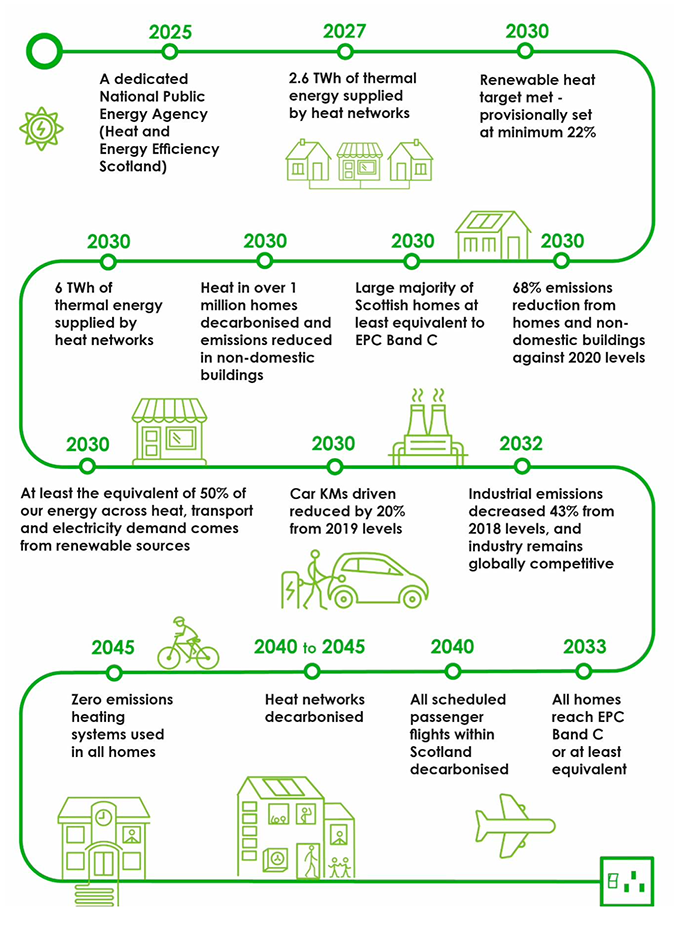
Contact
Email: energystrategy@gov.scot
There is a problem
Thanks for your feedback